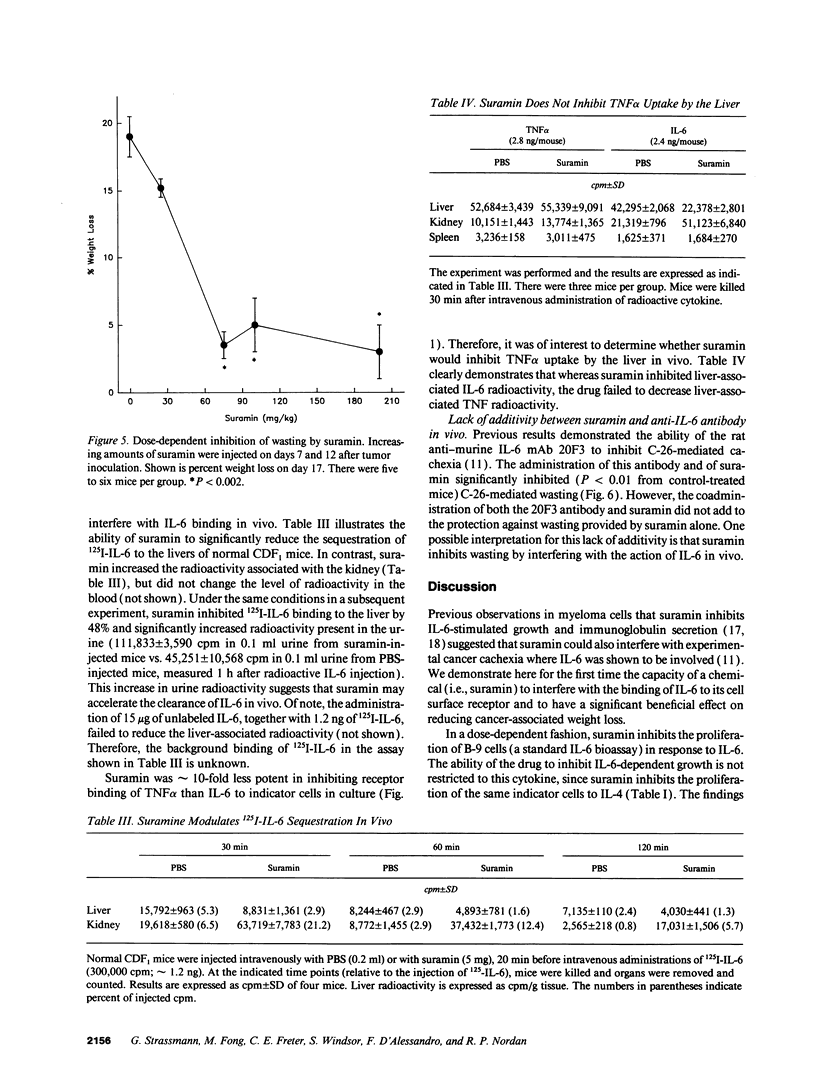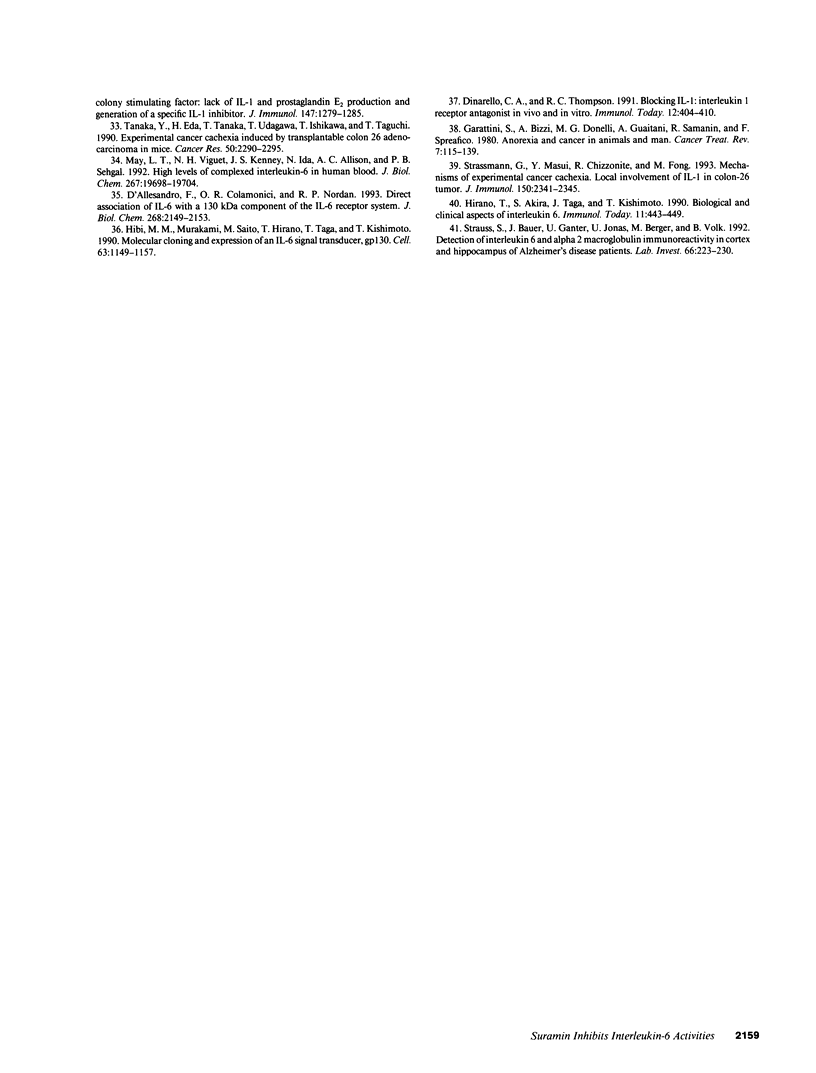Abstract
Neoplastic diseases are frequently associated with metabolic changes collectively known as cancer cachexia. The presence of cachexia complicates therapeutic intervention and is an important cause of death in cancer patients. At present there is no effective treatment for cachexia. Recently, the involvement of interleukin-6 (IL-6) in the wasting of colon-26 adenocarcinoma-bearing mice was demonstrated. The research presented here establishes an anticachectic role for the experimental drug suramin, since it partially blocks (up to 60%) the catabolic effects associated with the growth of this tumor in vivo. Suramin prevents the binding of IL-6 to its cell surface receptor subunits, as demonstrated by radioreceptor binding assay and affinity crosslinking experiments. Furthermore, the uptake of radioactive IL-6 by the liver is significantly reduced in suramin-treated mice. On the other hand, the drug is approximately 10-fold less potent in inhibiting the binding of tumor necrosis factor-alpha to indicator cell line in vitro and fails to block liver uptake of this cytokine in vivo. Collectively, these results suggest that suramin inhibits cancer-associated wasting, in part by interfering with the binding of IL-6 to its receptor. Whether suramin inhibits the action of other factors/cytokines that may also participate in colon-26-mediated cachexia is not yet known.
Full text
PDF







Images in this article
Selected References
These references are in PubMed. This may not be the complete list of references from this article.
- Betsholtz C., Johnsson A., Heldin C. H., Westermark B. Efficient reversion of simian sarcoma virus-transformation and inhibition of growth factor-induced mitogenesis by suramin. Proc Natl Acad Sci U S A. 1986 Sep;83(17):6440–6444. doi: 10.1073/pnas.83.17.6440. [DOI] [PMC free article] [PubMed] [Google Scholar]
- Beutler B., Mahoney J., Le Trang N., Pekala P., Cerami A. Purification of cachectin, a lipoprotein lipase-suppressing hormone secreted by endotoxin-induced RAW 264.7 cells. J Exp Med. 1985 May 1;161(5):984–995. doi: 10.1084/jem.161.5.984. [DOI] [PMC free article] [PubMed] [Google Scholar]
- Bojanowski K., Lelievre S., Markovits J., Couprie J., Jacquemin-Sablon A., Larsen A. K. Suramin is an inhibitor of DNA topoisomerase II in vitro and in Chinese hamster fibrosarcoma cells. Proc Natl Acad Sci U S A. 1992 Apr 1;89(7):3025–3029. doi: 10.1073/pnas.89.7.3025. [DOI] [PMC free article] [PubMed] [Google Scholar]
- Broder S., Yarchoan R., Collins J. M., Lane H. C., Markham P. D., Klecker R. W., Redfield R. R., Mitsuya H., Hoth D. F., Gelmann E. Effects of suramin on HTLV-III/LAV infection presenting as Kaposi's sarcoma or AIDS-related complex: clinical pharmacology and suppression of virus replication in vivo. Lancet. 1985 Sep 21;2(8456):627–630. doi: 10.1016/s0140-6736(85)90002-9. [DOI] [PubMed] [Google Scholar]
- Chlebowski R. T. Critical evaluation of the role of nutritional support with chemotherapy. Cancer. 1985 Jan 1;55(1 Suppl):268–272. doi: 10.1002/1097-0142(19850101)55:1+<268::aid-cncr2820551311>3.0.co;2-2. [DOI] [PubMed] [Google Scholar]
- Coffey R. J., Jr, Leof E. B., Shipley G. D., Moses H. L. Suramin inhibition of growth factor receptor binding and mitogenicity in AKR-2B cells. J Cell Physiol. 1987 Jul;132(1):143–148. doi: 10.1002/jcp.1041320120. [DOI] [PubMed] [Google Scholar]
- D'Alessandro F., Colamonici O. R., Nordan R. P. Direct association of interleukin-6 with a 130-kDa component of the interleukin-6 receptor system. J Biol Chem. 1993 Jan 25;268(3):2149–2153. [PubMed] [Google Scholar]
- De Clercq E. Suramin: a potent inhibitor of the reverse transcriptase of RNA tumor viruses. Cancer Lett. 1979 Nov;8(1):9–22. doi: 10.1016/0304-3835(79)90017-x. [DOI] [PubMed] [Google Scholar]
- Dewys W. D., Begg C., Lavin P. T., Band P. R., Bennett J. M., Bertino J. R., Cohen M. H., Douglass H. O., Jr, Engstrom P. F., Ezdinli E. Z. Prognostic effect of weight loss prior to chemotherapy in cancer patients. Eastern Cooperative Oncology Group. Am J Med. 1980 Oct;69(4):491–497. doi: 10.1016/s0149-2918(05)80001-3. [DOI] [PubMed] [Google Scholar]
- Dinarello C. A., Thompson R. C. Blocking IL-1: interleukin 1 receptor antagonist in vivo and in vitro. Immunol Today. 1991 Nov;12(11):404–410. doi: 10.1016/0167-5699(91)90142-G. [DOI] [PubMed] [Google Scholar]
- Dower S. K., Kronheim S. R., March C. J., Conlon P. J., Hopp T. P., Gillis S., Urdal D. L. Detection and characterization of high affinity plasma membrane receptors for human interleukin 1. J Exp Med. 1985 Aug 1;162(2):501–515. doi: 10.1084/jem.162.2.501. [DOI] [PMC free article] [PubMed] [Google Scholar]
- Fantini J., Rognoni J. B., Roccabianca M., Pommier G., Marvaldi J. Suramin inhibits cell growth and glycolytic activity and triggers differentiation of human colic adenocarcinoma cell clone HT29-D4. J Biol Chem. 1989 Jun 15;264(17):10282–10286. [PubMed] [Google Scholar]
- Garattini S., Bizzi A., Donelli M. G., Guaitani A., Samanin R., Spreafico F. Anorexia and cancer in animals and man. Cancer Treat Rev. 1980 Sep;7(3):115–139. doi: 10.1016/s0305-7372(80)80027-2. [DOI] [PubMed] [Google Scholar]
- Hibi M., Murakami M., Saito M., Hirano T., Taga T., Kishimoto T. Molecular cloning and expression of an IL-6 signal transducer, gp130. Cell. 1990 Dec 21;63(6):1149–1157. doi: 10.1016/0092-8674(90)90411-7. [DOI] [PubMed] [Google Scholar]
- Hirano T., Akira S., Taga T., Kishimoto T. Biological and clinical aspects of interleukin 6. Immunol Today. 1990 Dec;11(12):443–449. doi: 10.1016/0167-5699(90)90173-7. [DOI] [PubMed] [Google Scholar]
- Huang J. S., Huang S. S., Kuo M. D. Bovine brain-derived growth factor. Purification and characterization of its interaction with responsive cells. J Biol Chem. 1986 Sep 5;261(25):11600–11607. [PubMed] [Google Scholar]
- Langstein H. N., Norton J. A. Mechanisms of cancer cachexia. Hematol Oncol Clin North Am. 1991 Feb;5(1):103–123. [PubMed] [Google Scholar]
- May L. T., Viguet H., Kenney J. S., Ida N., Allison A. C., Sehgal P. B. High levels of "complexed" interleukin-6 in human blood. J Biol Chem. 1992 Sep 25;267(27):19698–19704. [PubMed] [Google Scholar]
- Nakajima M., DeChavigny A., Johnson C. E., Hamada J., Stein C. A., Nicolson G. L. Suramin. A potent inhibitor of melanoma heparanase and invasion. J Biol Chem. 1991 May 25;266(15):9661–9666. [PubMed] [Google Scholar]
- Pollak M., Richard M. Suramin blockade of insulinlike growth factor I-stimulated proliferation of human osteosarcoma cells. J Natl Cancer Inst. 1990 Aug 15;82(16):1349–1352. doi: 10.1093/jnci/82.16.1349. [DOI] [PubMed] [Google Scholar]
- Sharon M., Klausner R. D., Cullen B. R., Chizzonite R., Leonard W. J. Novel interleukin-2 receptor subunit detected by cross-linking under high-affinity conditions. Science. 1986 Nov 14;234(4778):859–863. doi: 10.1126/science.3095922. [DOI] [PubMed] [Google Scholar]
- Stein C. A., LaRocca R. V., Thomas R., McAtee N., Myers C. E. Suramin: an anticancer drug with a unique mechanism of action. J Clin Oncol. 1989 Apr;7(4):499–508. doi: 10.1200/JCO.1989.7.4.499. [DOI] [PubMed] [Google Scholar]
- Strassmann G., Fong M., Kenney J. S., Jacob C. O. Evidence for the involvement of interleukin 6 in experimental cancer cachexia. J Clin Invest. 1992 May;89(5):1681–1684. doi: 10.1172/JCI115767. [DOI] [PMC free article] [PubMed] [Google Scholar]
- Strassmann G., Jacob C. O., Evans R., Beall D., Fong M. Mechanisms of experimental cancer cachexia. Interaction between mononuclear phagocytes and colon-26 carcinoma and its relevance to IL-6-mediated cancer cachexia. J Immunol. 1992 Jun 1;148(11):3674–3678. [PubMed] [Google Scholar]
- Strassmann G., Masui Y., Chizzonite R., Fong M. Mechanisms of experimental cancer cachexia. Local involvement of IL-1 in colon-26 tumor. J Immunol. 1993 Mar 15;150(6):2341–2345. [PubMed] [Google Scholar]
- Strauss S., Bauer J., Ganter U., Jonas U., Berger M., Volk B. Detection of interleukin-6 and alpha 2-macroglobulin immunoreactivity in cortex and hippocampus of Alzheimer's disease patients. Lab Invest. 1992 Feb;66(2):223–230. [PubMed] [Google Scholar]
- Tanaka Y., Eda H., Tanaka T., Udagawa T., Ishikawa T., Horii I., Ishitsuka H., Kataoka T., Taguchi T. Experimental cancer cachexia induced by transplantable colon 26 adenocarcinoma in mice. Cancer Res. 1990 Apr 15;50(8):2290–2295. [PubMed] [Google Scholar]
- Taylor C. W., Lui R., Fanta P., Salmon S. E. Effects of suramin on in vitro growth of fresh human tumors. J Natl Cancer Inst. 1992 Apr 1;84(7):489–494. doi: 10.1093/jnci/84.7.489. [DOI] [PubMed] [Google Scholar]
- Tisdale M. J. Cancer cachexia. Br J Cancer. 1991 Mar;63(3):337–342. doi: 10.1038/bjc.1991.80. [DOI] [PMC free article] [PubMed] [Google Scholar]
- Tracey K. J., Cerami A. Tumor necrosis factor in the malnutrition (cachexia) of infection and cancer. Am J Trop Med Hyg. 1992 Jul;47(1 Pt 2):2–7. doi: 10.4269/ajtmh.1992.47.2. [DOI] [PubMed] [Google Scholar]
- Tracey K. J., Wei H., Manogue K. R., Fong Y., Hesse D. G., Nguyen H. T., Kuo G. C., Beutler B., Cotran R. S., Cerami A. Cachectin/tumor necrosis factor induces cachexia, anemia, and inflammation. J Exp Med. 1988 Mar 1;167(3):1211–1227. doi: 10.1084/jem.167.3.1211. [DOI] [PMC free article] [PubMed] [Google Scholar]
- Vignon F., Prebois C., Rochefort H. Inhibition of breast cancer growth by suramin. J Natl Cancer Inst. 1992 Jan 1;84(1):38–42. doi: 10.1093/jnci/84.1.38. [DOI] [PubMed] [Google Scholar]
- Vlassara H., Spiegel R. J., San Doval D., Cerami A. Reduced plasma lipoprotein lipase activity in patients with malignancy-associated weight loss. Horm Metab Res. 1986 Oct;18(10):698–703. doi: 10.1055/s-2007-1012410. [DOI] [PubMed] [Google Scholar]
- Williams L. T., Tremble P. M., Lavin M. F., Sunday M. E. Platelet-derived growth factor receptors form a high affinity state in membrane preparations. Kinetics and affinity cross-linking studies. J Biol Chem. 1984 Apr 25;259(8):5287–5294. [PubMed] [Google Scholar]
- Zaniboni A. Suramin: the discovery of an old anticancer drug. Med Oncol Tumor Pharmacother. 1990;7(4):287–290. doi: 10.1007/BF02987108. [DOI] [PubMed] [Google Scholar]




